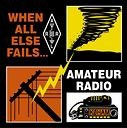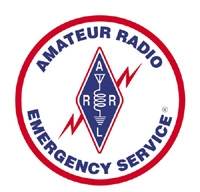
 SUMTER COUNTY
SUMTER COUNTY
Amateur Radio Emergency Services Association (ARES)
Sumter County, Florida
APRS - Android
APRSdroid is an Android smartphone application for Amateur Radio operators and requires a FCC license to use. It allows periodic reporting of your position to the APRS network which displays nearby amateur radio stations and facilitates the exchange of APRSmessages. APRSdroid is Open Source Software written in Scala and licensed under the GPLv2. It works extremely well for mobile events that a ham radio operator may be supporting.
You can use APRSdroid to connect to the APRS network via different means:
- APRS-IS via Internet (WiFi or mobile data connection)
- AFSK (audio connection between your radio and the smartphone
- Bluetooth-serial connection to a TNC
APRSdroid can be used in different ways, according to your requirements. By default, it connects to APRS via the Internet (APRS-IS) and deploys SmartBeaconingTM for position reports. If you what to change its configuration, there are three main areas you should consider:
- APRS Settings (your call sign and SSID, plus eventual pass code for APRS-IS)
- Position Reports (how and how often your position is reported)
- APRS Connection (how you connect to a radio or the APRS-IS network)
For your own position reports, you can choose among the following configuration ("Location Source")
- SmartBeaconingTM (position is posted automatically depending on your movement speed)
- Periodic position reports (you can use the GPS or the network location feature here, reducing the position precision)
- Manual position entry (e.g. for tablets which stay at home; use this to completely disable position reporting).
There are also several ways to connect to the APRS network ("Connection Protocols"):
- APRS-IS APRS over the Internet, using a WiFi or mobile data connection
- Connection with a TNC (currently supported only by using a Bluetooth serial adapter attached to a radio
- Direct audio connection to a radio (AFSK)
- Kenwood APRS-capable NT/Mobile integration (APRSdroid simulates a NMEA-GPS to feed the Kenwood and parses its waypoint output)
Setting Up APRSDroid Software Application on You Phone
Go to the Google Play Store and buy APRSDroid. Currently, it cost $4.99 and is well worth everything that its creator is asking. After installing it on your phone, some configuration is needed.
| 1. Open the application and go to preferences 2. FCC Call Sign Enter your FCC call sign. In APRS you will often see stations with an additional suffix identifier after their call sign and is called a SSID. This is to delineate between different communication methods that a radio operator may us - base station, HT, mobile, cell phone. When APRSDroid say "without SSID," it means without the suffix identifier. Just enter your call sign. 3. APRS-IS pass code Assuming that you don't have an APRS-IS pass code, request one through the link in the preference menu now. APRS has an Internet backbone. It's what lets you see radio traffic through websites like aprs.fi. It is also what lets APRS text messages reach beyond the local area. Note: APRS-IS will require proof of your license, as they should. You will be passing traffic across their network that will eventually cross the RF line; so they have a requirement to verify that you are licensed. If you've registered for a service like Echolink, then you have some view of the concept. Once you have your APRS-IS pass code, type it into the pass code field in APRSDroid and save it for future reference. 4. SSID Choose what type of SSID you will be by using the drop down menu. Typically you will be some type of vehicle (-9) or if walking a cell phone (-5). 5. APRS Symbol You can select a car (/>), truck (/k), van(/v), etc. for the icon that is displayed on the map. See http://www.aprs.org/symbols.html for more information. If you are going to use it through a cell network every time, then you may use the default, a phone handset (/$) 6. Comment Field This is for providing contact information such as a call sign. If you use a phone number, it may be picked up on the Internet. 7. SmartBeaconing Unless you are a base station, then SmartBeaconing should be turned on. Some software decides to update your position after a set amount of time regardless of whether you are moving or not. SmartBeaconing knows to transmit more frequently when your are moving quickly or changing direction. 8. SmartBeaconing Location Settings This is where one can fine tune. For a stationary station, any reporting more often than once every 30 minutes is a bit overkill for your cell phone battery unless your are a weather station (use 15 minutes). Unlike your computer, a packet collision is not resent. Overloading the frequency means preventing messages from getting through. Northwest APRS recommends no more frequent updates than the following for mobile stations: Using no relay or WIDE1-1, then 1 minute Using WIDE1-1 or WIDE2-1, then 2 minutes Using WIDE1-1 to WIDE2-2, then 5 minutes where WIDE202 is recommended path for stationary stations, WIDE1-1, WIDE2-1 for mobile, and WIDE1-1, WIDE2-2 if you are in a very rural or mountainous area. APRS.net recommends the following speed settings for normal driving:
9. Position Privacy If you want someone to know that you are in radio range, but not specifically change you position ambiguity. Usually the setting of 2 is used along with turning off bearing, and altitude. Leaving speed on allows the dispatcher to determine whether you are moving or not. 10 Connection Protocol Select Bluetooth TNC. Also, the Mobilinkd TNC should be selected buy no other settings. 11. Connection Preferences Client mode should be checked, but make no changes to Channel (blank), TNC init string (blank), and TNC init delay (300). APRS digi path is the main item that should be changed. See # 8 above, but usually it will be "WIDE1-1, WIDE2-1" if your are going to be mobile. 12. Keep Screen Awake If you are frequently referring to your phone, then enable "keep screen awake" and you are ready to use |
APRS Settings
Call sign and pass code These values are used to identify one as a HAM radio operator. The pass code is required by the APRS-IS network and not specific to APRSdroid. You can use your existing APRS-IS pass code or request a passcode if you are new to APRS-IS. No pass code is required if you wnat to directly connect APRSdroid to a radio or TNC.
SSID The SSID represent the basic type of device you want to represent. Typical values are 5 for cell phone, 7 for NT, 9 for a mobile radio, and 10 for Internet (APRS-IS).
Position Reports
Symbol and Comment In the APRS symbol field you can enter the text representation of your symbol. /$ represents a phone booth icon, /[ is a running person, and there are many more. You can use overlay symbols as well! The comment can contain information about yourself and it is recommended to add your ORG in it. Just write the frequency as xxx.xxxMHz or use other optional fields.
Location Source and Settings Choose how APRSdroid will obtain your geographic location and how often it will report it.
SmartBeaconing Your position is posted according to your movement speed and direction. Currently, no settings are possible, the update interval is between 15 second (corner-pegging) and 20 minutes.
Periodic GPS/Network Position You can set the minimum update time interval in minutes and update distance in km. The values for distance and interval are always check together, before an update is sent. This is meant to reduce the traffic on the APRS radio band. If you want to send updates every minute, regardless of your movement, you have to set the following:
- Update interval: 1 [min]
- Update distance: - [km]
Unfortunately, there is no easy way in the Android to receive location updates when either condition is met, without using too much battery reserve.
The GPS precision setting allows to tune position quality vs. battery use. Low will use the firstGPS result available; Medium will keep GPS on for 30 seconds and use the latest result; and High will keep the GPS on all the time. It is recommended to sue SmartBeaconing instead of the High setting.
The network location option allows to sue GSM/3G and WiFi networks to obtain your position. This data is not very precise (100m..10km) an can cause a duplicate position reports. However, it has a significantly lower battery use than GPS.
Manual Position You can enter your coordinates as decimal values. Enter negative values for south and west. As an example, the center of Los Angeles would be Latitude: 34.052222 and Longitude: -118.243611. If you want to keep your position private, disable Automatic Posting. Your position will only be announced if you use the Single Shot button. However, you may not receive messages to your call sign without posting your position.
Position privacy You can "hide your tracks" by setting the positon ambiguity of your reports or disable the posting of speed and/or direction. It is not recommended to sue this in combination with Smart Beaconing.
APRS Connection Use this setting to choose how APRSdroid should connect into the APRS network. You can configure the chosen protocol using Connection Preferences.
TCP Connection This connects you to the APRS-IS network. It is the default, suggested connection type, and allows to utilize APRSdroid over the Internet. This setting maintains a bidirectional connection to an APRS-IS server, as long as the tracking service is running. You can use the Neighbor radius to set the areas of interest, and the Message filter to receive selected packets. You should choose a rotate address for you region from the Tier 2 APRS-IS servers or a server from the APRS-IS server list. It is also possible to connect to an iGate near your location.
UDP (not recommended) The packet is sent via UDP to port 8080. This is unreliable and packets may be lost without a message. Nevertheless, because there is no feedback, APRSdroid show them as "UDP OK". You need to check an external reference like aprs.fi to see if your packets actually arrived.
HTTP Post (not recommended) Packets are sent via HTTP. This is more reliable than UDP, however causes higher traffic levels.
Bluetooth TNC This allows to connect APRSdroid to a TNC using a Bluetooth serial (SPP) adapter. You need to pair the Bluetooth serial adapter in the Android Bluetooth preferences, than you can use it to connect to a TNC in KISS mode. It is possible to set the Bluetooth channel to connect to the TNC (leave empty for auto-discovery of SPP). To initialize the TNC, you can set a TNC init string. Multiple lines can be entered, APRSdroid will wait the init delay time after each new line. In some cases, you might have a Bluetooth device operating in client mode (initiating a connection to your smartphone). For these seldom situations (or to directly connect two Androids), you can disable Client Mode.
Last Update: 06/28/2018 © Copyright Sumter County ARES. All Rights Reserved.